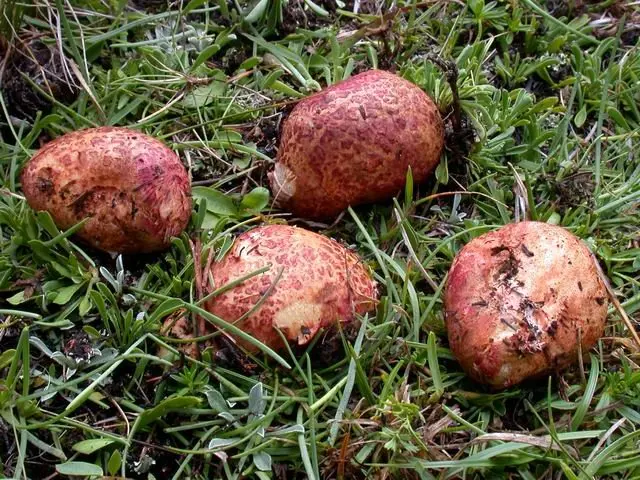Pinkish rhizopogon (Rhizopogon roseolus)
- Division: Basidiomycota (Basidiomycetes)
- Subdivision: Agaricomycotina (Agaricomycetes)
- Class: Agaricomycetes (Agaricomycetes)
- Subclass: Agaricomycetidae (Agaricomycetes)
- Order: Boletales (Boletales)
- Family: Rhizopogonaceae (Rhizopogonaceae)
- Genus: Rhizopogon (Rizopogon)
- Type: Rhizopogon roseolus (Rhizopogon pinkish)
- Truffle pinking
- Truffle blushing
- Truffle pinking
- Truffle blushing

fruiting body:
the fruiting bodies of the fungus have an irregularly rounded or tuberous shape. Most of the fungus is formed underground, only single dark strands of mycelium are visible on the surface. The diameter of the mushroom is about one to five centimeters. The peridium of the fungus is white at first, but when pressed or exposed to air, the peridium acquires a red tint. In a mature mushroom, the peridium is olive-brown or yellowish.
The outer surface of the fungus is thin white, then becomes yellowish or olive-brown. When pressed, it turns red. The surface of the fruiting body is first velvety, then smooth. The inner part, in which the spores are located, is fleshy, oily, dense. First whitish, then becomes yellowish from mature spores or brownish-greenish. The flesh has no particular smell or taste, with many narrow sinuous chambers, two to three centimeters long, which are filled with spores. In the lower part of the fruiting body there are whitish roots – rhizomorphs.
Disputes:
yellowish, smooth, fusiform and ellipsoid. There are two drops of oil along the edges of the spores. Spore powder: light lemon yellow.
Spread:
Pinkish Rhizopogon is found in spruce, pine and pine-oak forests, as well as in mixed and deciduous forests, mainly under spruces and pines, but also occurs under other tree species. Grows in soil and on leafy litter. Doesn’t happen often. It grows shallow in the soil or on its surface. Often grows in groups. Fruiting from June to October.
Similarity:
Rhizopogon pinkish somewhat resembles Rhizopogon ordinary (Rhizopogon vulgaris), which is distinguished by a gray-brown color and fruiting bodies that do not redden when pressed.
Edibility:
little known edible mushroom. It is eaten only at a young age.









